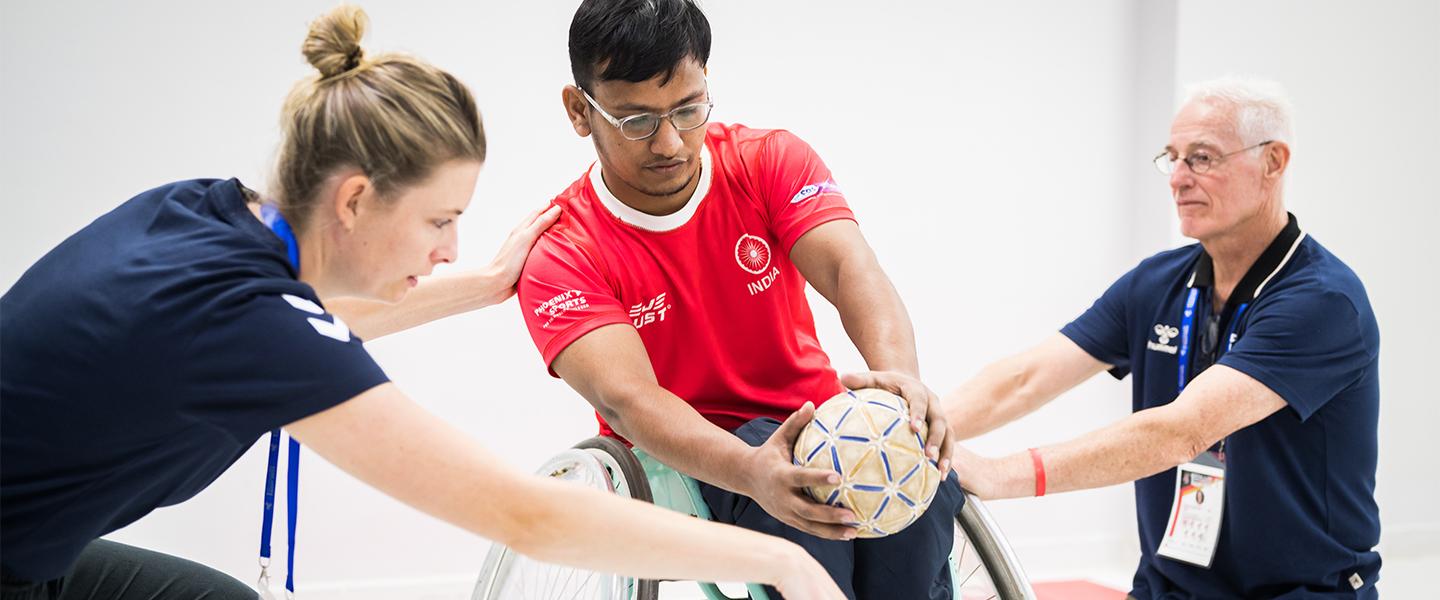Classification: How it enables wheelchair handball to be played
21 Sep. 2022

The inaugural IHF Four-a-Side Wheelchair Handball World Championship will throw off in the Dr Hassan Moustafa Sports Hall in 6 of October, Egypt, on 22 September 2022, as six teams will play for the coveted gold medal, which will be awarded after four days of action.
To ensure the matching of the teams – i.e., the motoric capacity of a team must match the motoric capacity of the opponents – each player undergoes a series of tests conducted on two separate days before the start of Egypt 2022.
This is commonly known as “classification”, which consists of three parts. The first one was done before the teams arrived in Egypt, a pre-event eligibility check via a Medical Diagnostic Form, signed by a certified medical doctor.
The second part has been done on site, by a panel of three recognised classifiers, who have assessed each player during a 15-minute session to determine if the player meets the Minimum Impairment Criteria (MIC).
These MIC are based on the players’ functional capacity to complete the skills necessary to play – pushing, pivoting, shooting, dribbling, passing and catching. It is not an assessment of a player’s level of skill, merely their functional capacity to complete the task.
The panel for the first edition of the IHF Four-a-Side Wheelchair Handball Championship was formed by Mr Kees van Breukelen, Mr Frits de Jong and Mrs Lotte Marissen.
“Classification for wheelchair handball is the same for wheelchair basketball, for example, and it consists in a verification of the motricity of the player, which is mostly the trunk function.
“In wheelchair handball, the shoulders and the arms are mostly all perfect. But, because of injuries of the spinal cord of amputations of inferior members, the players have a more or less impaired function of the trunk,” says van Breukelen.
The main parts of the classification for this competition have been forward flexions, rotations, lateral flexion and, after all the exams have been completed, the assessment is done, a profile for the player is made and each player is scored.
A colour code will then be used to identify the class of each player. A sticker with the code and the player’s number will be placed on the back of the wheelchair. There are four classes:
Class 1: green (1 point)
Class 2: yellow (2 points)
Class 3: blue (3 points)
Class 4: red (4 points)
“The Class 4 players are the ones with the least motoric problems, the highest motoric capacity. This is true the other way around, with Class 1 players, who will have a green sticker, having the biggest motoric problems. Therefore, when the scorers, referees and even fans see a player with a green sticker, they know that the player has the least motoric capacities, Class 1.
“Each player will have a point score to each motoric capacity – Class 1 have 1 point, Class 2 – 2 points, Class 3 – 3 points and Class 4 – 4 points. For each team in the competition, there cannot be players with more than 12 points on the court at the same time,” adds van Breukelen.
The teams that underwent the process had little trouble, especially India, whose players had already been previously classified, as they were members of the national wheelchair basketball team.
The last part of the assessment is an Observation Assessment, which is particularly important as this is the first IHF Four-a-Side Wheelchair Handball World Championship. The purpose is to check if the athlete’s performance in the competition matches the results of the preceding Physical/Technical Assessment.
But how is the assessment panel formed?
“Ideally, we have a combination of members with a medical and a technical background. This is what happened here, with Mrs Lotte Marissen having a medical background, I also have a medical background, while Mr Frits de Jong is an experienced wheelchair basketball coach and player, because he has polio himself.
“Together, we can make the best decision between us and we have also studied classification for this type of competition intensely,” concludes van Breukelen.

